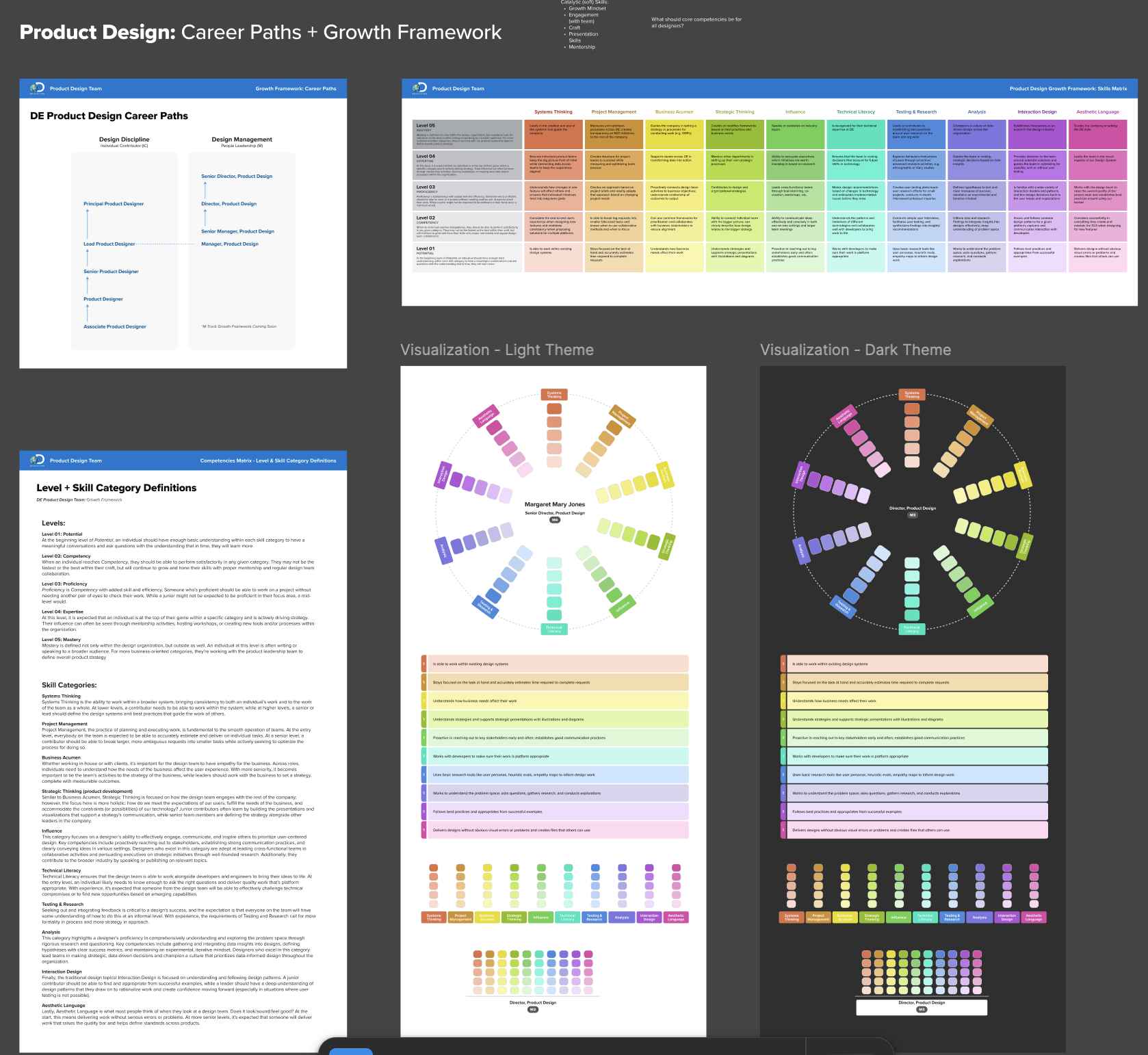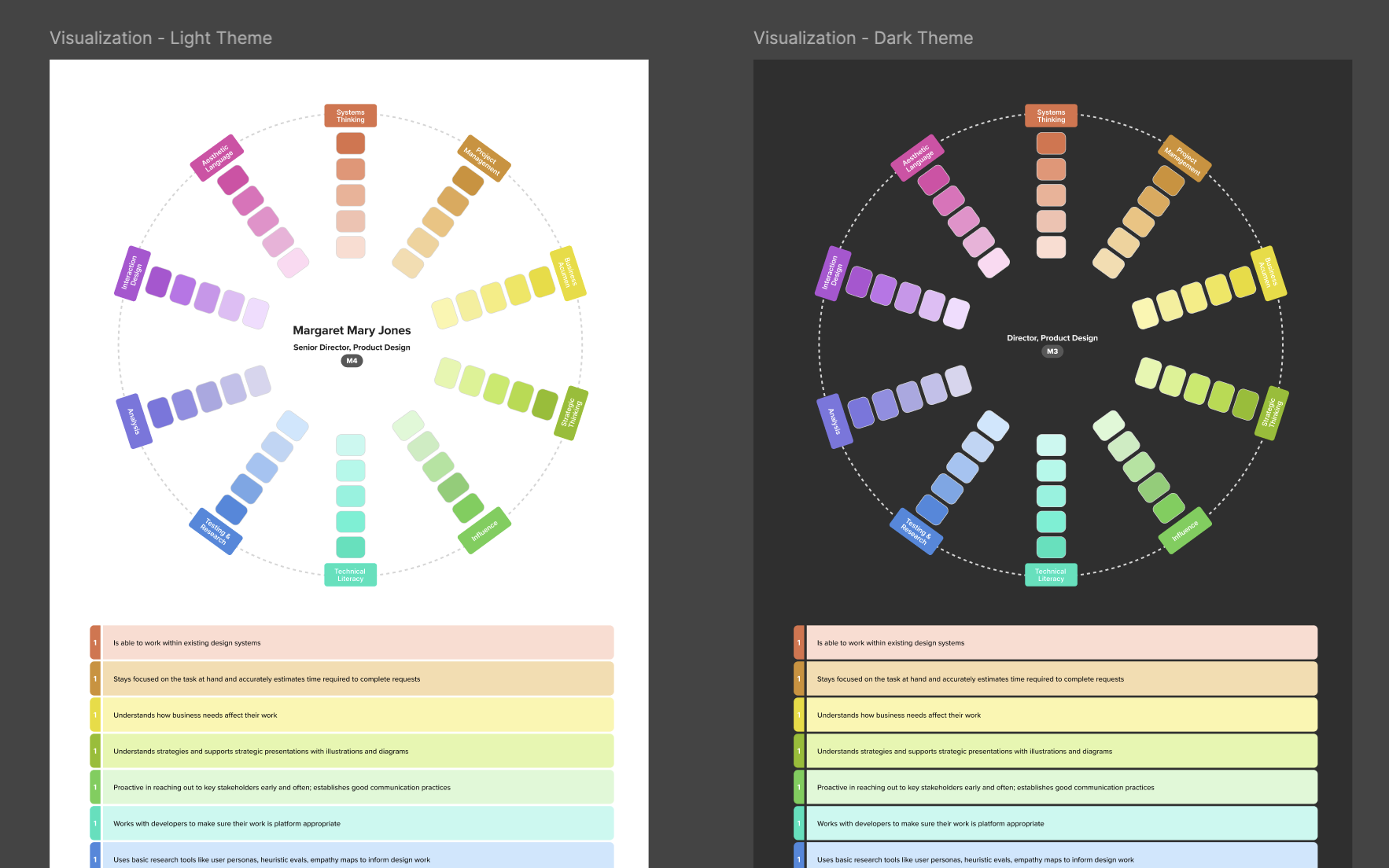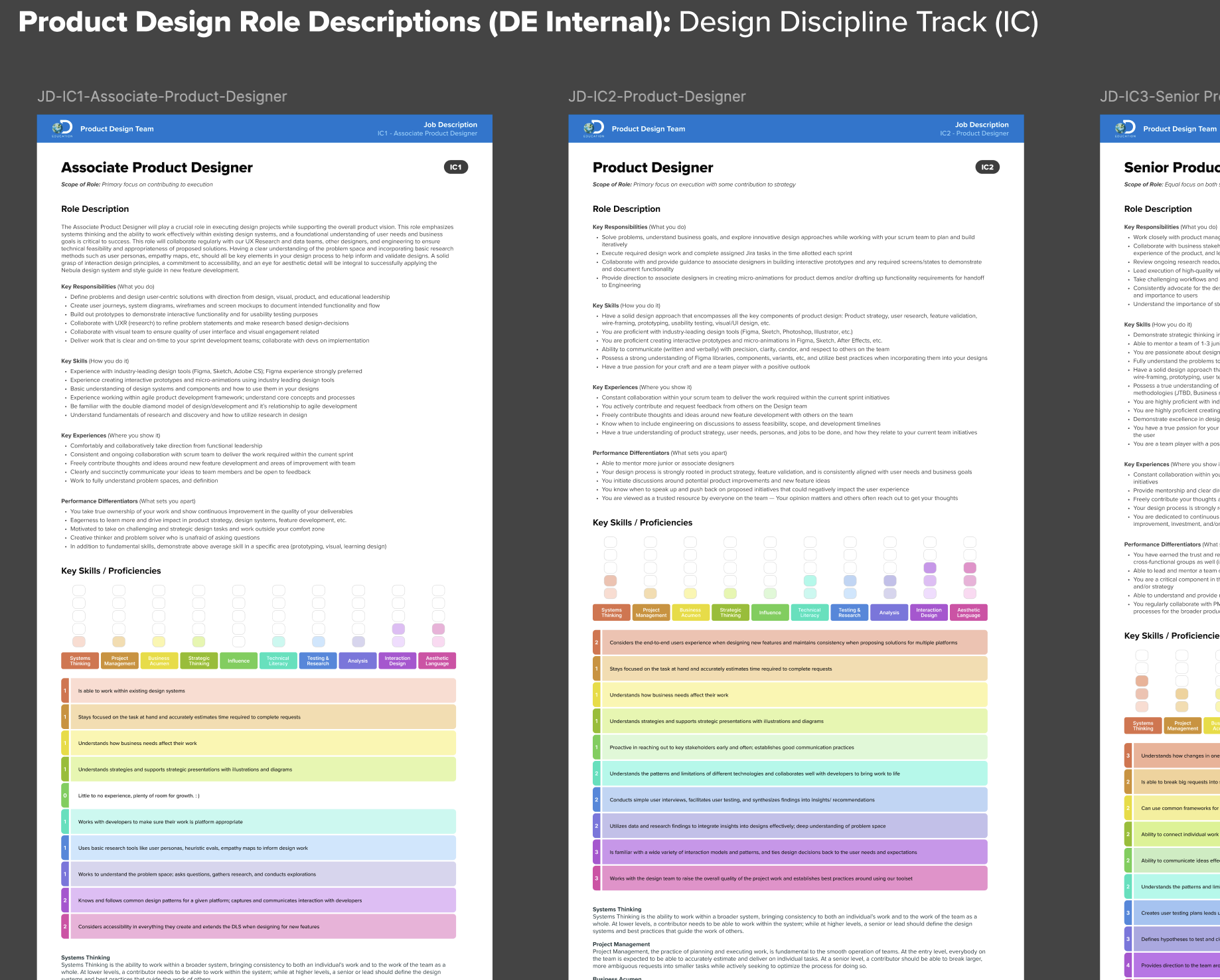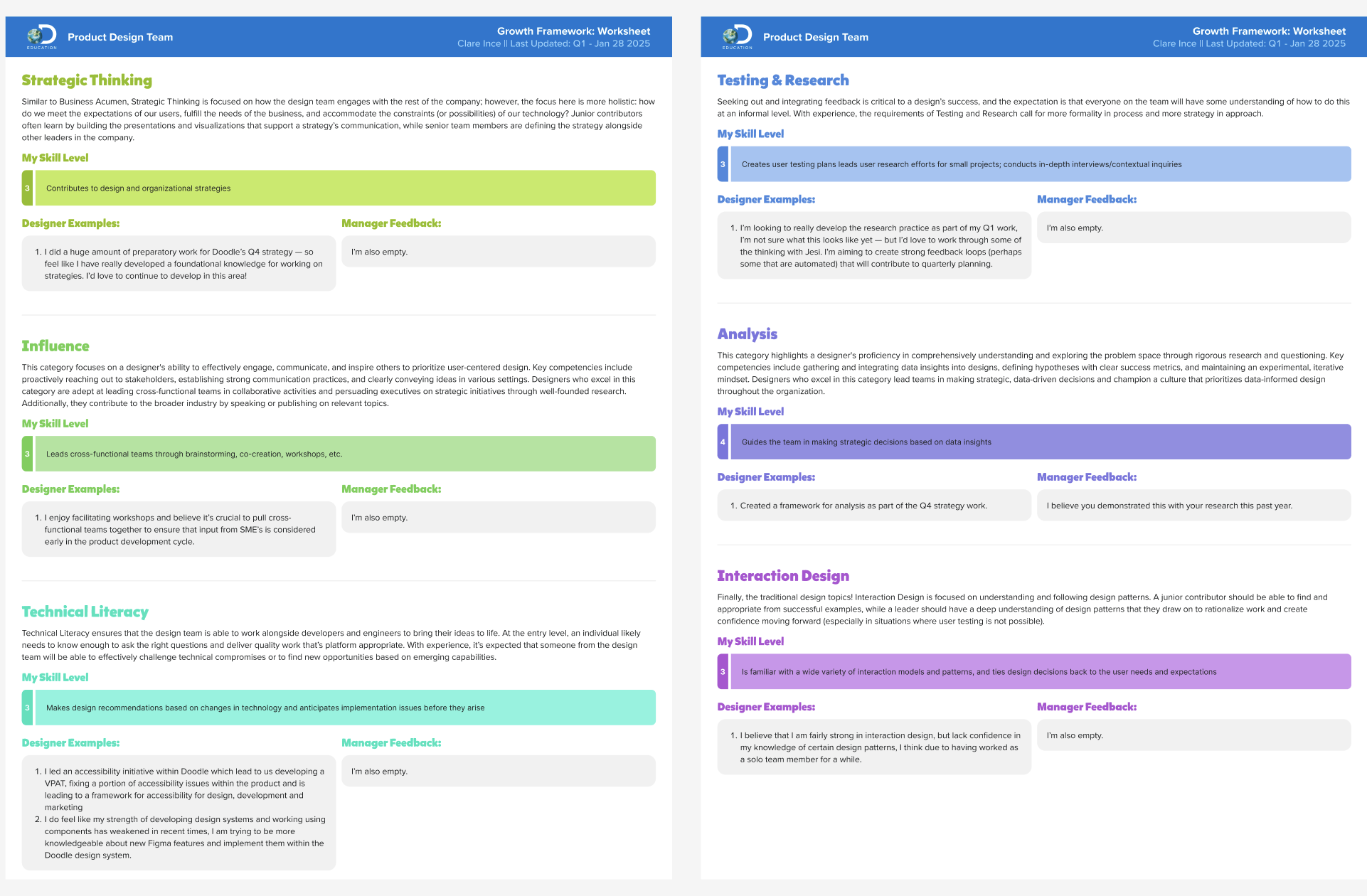Jessica Loredo • Discovery Education • March 2025
Designing for Growth: A Structured Framework for Career Development in Product Design
At Discovery Education, designers had no standardized way to assess their own growth, track skill progression, or have meaningful career development conversations with managers. Growth was often measured through loose qualitative feedback, and career discussions lacked clear benchmarks. As we scaled our team, we needed a system that provided clarity, structure, and flexibility—one that empowered designers to take ownership of their professional development while giving managers a concrete framework for guidance.

The Problem
Before implementing this framework, designers at Discovery Education had no structured way to assess their skill levels beyond the subjective perspective of their managers. Career growth discussions were based on qualitative feedback rather than a structured competency model. While HR had initiated goal-setting initiatives, these were loosely defined and did not effectively measure design skill progression.
Managers also struggled to guide designers on professional development outside of product-focused or general personal growth goals. HR lacked a structured career growth framework tailored to design roles, making it difficult to evaluate expertise and set clear advancement pathways. In fact, HR eventually borrowed elements from this framework to build their own.
Additionally, the existing framework we referenced (Medium: A Growth Framework for Design teams) was missing key competencies—particularly soft skills and leadership growth. We added "influence", a category inspired by an unfinished framework from a former manager that we felt reflected some of the soft skills needed in working on product teams, and "analysis", recognizing that synthesizing insights is an essential skill for designers. The original model also lacked flexibility, which we saw as an opportunity to create a customizable framework tailored to individual career paths and specializations.
Finally, after reviewing the growth framework, we realized that while it provided valuable guidelines, it lacked an interactive component. Designers needed a way to track their progress, visualize their skill levels, and provide real-world examples of their abilities. This insight led to the creation of an accompanying worksheet, designed to facilitate self-assessment, manager feedback, and career planning.
The Approach
To develop the framework, I started by gathering initial feedback from managers and senior team members. These leaders provided feedback on the language and overall functionality of the system. They also had questions about how it related to seniority (associate vs senior) and how it would map into career pathing more broadly in alignment with corporate HR systems.
We then introduced the first iteration of framework in our Design Jam meeting, followed by a deeper discussion in our K-12 biweekly team meeting. Upon initial presentation of the system, we received positive feedback from the team, many of whom, had been looking for clearer understanding of their career growth and their status at the company.
Individual designers were curious about how to use or track their own skill levels across the framework. I anticipated they may want an easy way to interact with the growth framework rather than just reading through it. For this reason, I designed an accompanying set of worksheets.
I felt the best way to test the effectiveness of the framework and worksheets was through direct usage, so we had our leads pilot the system. Four to five designers reviewed the growth framework table, filled out the worksheets, and provided insights.
The feedback was overwhelmingly positive! Designers not only appreciated the clarity of growth framework table, but lauded the insights gathered from exploring their own work through the worksheets.
Through iteration, we improved the framework in several ways:
- Adjusted wording to align with Discovery Education’s corporate language.
- Added two new competency categories: Influence (soft skills, leadership) and Analysis (critical thinking and synthesis).
- Designed functional worksheets to make the framework interactive rather than just a reference document.
- Created radial visualizations to offer a more engaging way to track skills./
- Implemented a dark mode option, which also served as an opportunity to experiment with new variables.

Looking ahead, we are working on making the framework more flexible. While it currently applies to product designers broadly, we envision a customizable model where designers can swap competencies based on their specialization. For example, a designer focused on research might replace aesthetic competencies with deeper research-oriented skills.
Design
Iteration 1: Initial Framework Development
Goal: Create a structured yet adaptable model for tracking skill development.
Results
- Reviewed foundational framework and refined wording in each category and competency intersection to reflect design org needs.
- Pilot tested the framework with a small group of designers during quarterly reviews.
- Captured feedback from design team on categories and clarity of wording.

Iteration 2: Enhancing Engagement & Usability
Goal: Make the framework more interactive and useful for real discussions.
- Introduced radial visualizations to improve clarity and engagement.
- Designed the worksheet to encourage self-assessment and manager feedback.
- Gathered additional feedback, leading to minor usability improvements in layout and structure.

Iteration 3: Expansion & Specialization (In Progress)
Goal: Enable role-specific customization and alignment with HR.
- Exploring ways to allow designers to swap out competencies based on their career path.
- Collaborating with HR to align this framework with promotion and review processes.
- Future refinements to include new categories tailored to research-focused or design management roles.

Results & Impact
The feedback from designers and leadership has been overwhelmingly positive. Designers who have used the framework report that it provides clear insight into their strengths, areas for growth, and how they compare to seniority levels.
One direct success story involved a designer participating in an on-the-job training program for professionals on a work visa. When asked to provide documentation on her skills and development plan, we used the framework as a structured way to showcase her growth. Prior to this, there was no standardized way to provide such assessments.
Additionally, the framework is now being used in:
- Performance reviews
- Goal setting & career development planning
- Promotion discussions

We are currently working with HR to establish formal validation of this framework as an official tool for promotion decisions. The goal is for this system to serve as objective evidence of designer growth, making the promotion process more transparent and equitable.
Some designers have already adjusted their career plans based on insights from the framework. For example, one designer realized they wanted to improve in Strategic Thinking and set a goal to strengthen that skill. Others have noted that their self-perceptions didn’t always match the framework’s criteria, prompting them to take actionable steps to develop in areas they previously overlooked.
Reflection
While the framework has been well received, there are still areas for improvement:
- Continuous Improvement: Bi-annual team & culture survey includes questions about career pathing and the growth framework; survey results are incorporated into continuous improvement of framework.
- HR Alignment – Finalizing conversations with HR to ensure the framework is validated for promotions.
- Specialization Development – Exploring how to introduce customizable columns to adapt the framework for different design roles.
- Ongoing Iteration – Refining the framework’s wording and structure to improve clarity and usability.
Lessons Learned
This process reinforced the importance of feedback and iteration. While we approached the framework like a traditional design problem—prototype, test, refine—it was actual usage that provided the most valuable insights. We also learned that engagement is key. A static framework is useful, but providing interactive tools like the worksheet ensures greater adoption and buy-in.
By continuing to refine and expand this framework, we hope to create a comprehensive, adaptable system that not only supports individual designer growth but also strengthens the overall structure of career development at Discovery Education.